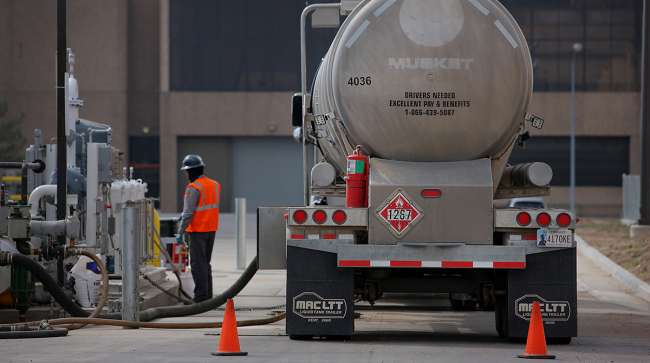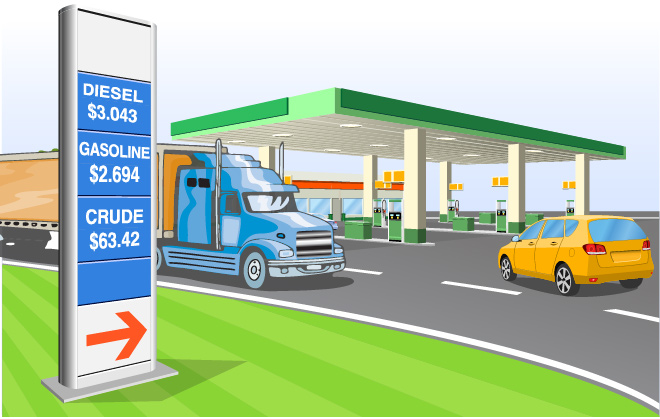Senior Reporter
Diesel Average Essentially Flat, Rising Just 0.1¢ to $3.043 a Gallon

The U.S. average retail price of diesel rose .01 cent to $3.043 as oil remained near $63 a barrel amid ongoing uncertainty over a U.S. trade war with China, but oil jumped later in the week as tensions eased.
Trucking’s main fuel costs 46.1 cents a gallon more than it did a year ago, when the price was $2.582, the Department of Energy reported April 9. It was the third increase in diesel’s average price after six consecutive declines. The price has risen 7.1 cents in that period.
The average regional price of diesel was mixed: unchanged on the East Coast, falling in four areas and rising in five others.
The national average price for regular gasoline slipped 0.6 cent to $2.694 a gallon, DOE’s Energy Information Administration said. The average is 27 cents higher than it was a year ago.
Average regional gasoline prices were also mixed: rising in four areas, falling in four others and unchanged in the Central Atlantic region.

Illustration by Transport Topics
EIA forecasts that drivers in the United States will pay an average of $2.74 per gallon this summer for regular gasoline, the highest average summer price in four years. The agency forecast is for the price of gas from April through September to be 26 cents a gallon higher than the average price last summer, largely reflecting changes in crude oil prices.
One truck maker credited the improved fuel efficiency of its new LT linehaul Class 8 model as its sales surged 50.1% in March compared with the year-ago period. Earlier, a third party tested the new tractor head-to-head against competing brands in actual runs.
“It was a significant win over a couple of the other truck makers. With another one, we were neck and neck. We came out ahead in all three cases, and on average, were 4% better than the competition [in fuel efficiency]”, said Jeff Sass, senior vice president of North America Truck Sales for Navistar Inc.
International Truck is a brand of Navistar Inc.
Meanwhile, twin plumes of black smoke from a Class 8 may be an increasing rarity, but the California Air Resources Board is considering significantly reducing its existing opacity limits for trucks using diesel fuel.
CARB has scheduled a hearing May 25 to discuss cutting its exhaust smoke limit to 5% from 40% for trucks equipped with diesel particulate filters.
West Texas Intermediate crude futures on Nymex closed at $63.42 per barrel April 9 compared with $63.01 on April 2, then closed at $66.82 on April 11.
Worries over the exchange of punitive tariffs between the United States and China added to concerns that oil is piling up at storage tanks in America’s biggest crude distribution hub in Oklahoma and that production from shale fields is on a relentless rise to record levels. That led the U.S. benchmark crude to dip below $62 the week of April 2 after touching a high of more than $66 the week before, according to Bloomberg News.
President Donald Trump predicted China will be first to buckle in the tug of war, his top economic adviser said as the countries are holding “back-channel discussions” to resolve the dispute, Bloomberg reported.
Chinese President Xi Jinping on April 10 reiterated pledges to open sectors from banking to auto manufacturing in a speech that also warned against returning to a “Cold War mentality” amid trade disputes with the United States.
Looking ahead to hurricane season, the Colorado State University Tropical Meteorology Project team predicts 14 named storms in the Atlantic from June 1 to Nov. 30. Of those, researchers expect seven to become hurricanes and three to reach major strength (Saffir/Simpson categories 3-5) with sustained winds of 111 mph or greater
The team predicts that hurricane activity will be about 135% of the average season. By comparison, last year’s activity was about 245% of the average season. 2017 was most notable for hurricanes Harvey, Irma and Maria, which devastated the United States and portions of the Caribbean — disrupting freight hauling, and fuel refineries and platforms, destroying homes and causing fatalities.
Although briefly hindered by platform outages and pipeline issues in December, U.S. crude oil production in the Gulf of Mexico increased slightly in 2017, reaching 1.65 million barrels a day, the highest annual level on record, EIA reported.
Oil production in the Gulf is expected to continue increasing in 2018 and 2019, based on forecasts in the EIA’s latest Short-Term Energy Outlook.




